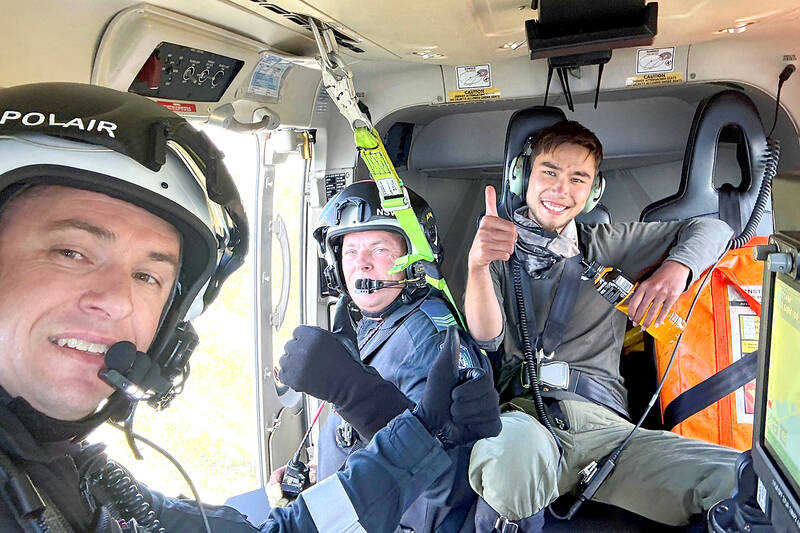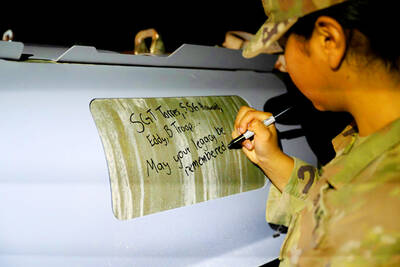A hiker survived on two muesli bars, foraged berries and creek water for two weeks while lost on a remote Australian mountain range, police said on Wednesday.
Hadi Nazari, a 23-year-old medical student from Melbourne, went missing on Dec. 26 when he separated from two hiking companions to take photographs in the Kosciuszko National Park in the Snowy Mountains in New South Wales state.
He was rescued after he approached a group of hikers on Wednesday afternoon, telling them he was lost and thirsty, Police Inspector Josh Broadfoot said.

Photo: AFP / New South Wales Police
Nazari had traveled more than 10km across steep and densely wooded terrain from where he was last seen, Broadfoot said.
A major land and air search had been launched the day Nazari went missing. More than 300 searchers were involved.
He was reunited with his two hiking friends on Wednesday before he was flown to a hospital for a medical assessment, Broadfoot said.
Nazari told police he had been “walking from morning until night,” Broadfoot said.
“He seems well: Amazing,” Broadfoot told reporters. “This is the 14th day we’ve been looking for him. For him to come out and be in such good spirits and in such great condition, it’s incredible.”
“There are some creeks up there, and he said he’s been finding water where he could and foraging for food where he could, in terms of berries. At one point, he said he found a couple of muesli bars in a hut, but other than that — 14 days and that’s very little food,” Broadfoot said.
Ambulance Inspector Adam Mower said that Nazari only needed treatment for dehydration.
“He’s in remarkable condition for a person who’s been missing for so long,” Mower said.
The national park surrounds Mount Kosciuszko, which is Australia’s highest peak at 2,228m.
Weather conditions are mild during the southern hemisphere summer.
Searchers had been optimistic that Nazari would be found alive. He was an experienced hiker equipped with a tent. Searchers had found his campfire, camera and hiking poles in the previous few days, suggesting that he was continuing to walk.

REVENGE: Trump said he had the support of the Syrian government for the strikes, which took place in response to an Islamic State attack on US soldiers last week The US launched large-scale airstrikes on more than 70 targets across Syria, the Pentagon said on Friday, fulfilling US President Donald Trump’s vow to strike back after the killing of two US soldiers. “This is not the beginning of a war — it is a declaration of vengeance,” US Secretary of Defense Pete Hegseth wrote on social media. “Today, we hunted and we killed our enemies. Lots of them. And we will continue.” The US Central Command said that fighter jets, attack helicopters and artillery targeted ISIS infrastructure and weapon sites. “All terrorists who are evil enough to attack Americans are hereby warned

‘POLITICAL LOYALTY’: The move breaks with decades of precedent among US administrations, which have tended to leave career ambassadors in their posts US President Donald Trump’s administration has ordered dozens of US ambassadors to step down, people familiar with the matter said, a precedent-breaking recall that would leave embassies abroad without US Senate-confirmed leadership. The envoys, career diplomats who were almost all named to their jobs under former US president Joe Biden, were told over the phone in the past few days they needed to depart in the next few weeks, the people said. They would not be fired, but finding new roles would be a challenge given that many are far along in their careers and opportunities for senior diplomats can

Seven wild Asiatic elephants were killed and a calf was injured when a high-speed passenger train collided with a herd crossing the tracks in India’s northeastern state of Assam early yesterday, local authorities said. The train driver spotted the herd of about 100 elephants and used the emergency brakes, but the train still hit some of the animals, Indian Railways spokesman Kapinjal Kishore Sharma told reporters. Five train coaches and the engine derailed following the impact, but there were no human casualties, Sharma said. Veterinarians carried out autopsies on the dead elephants, which were to be buried later in the day. The accident site

RUSHED: The US pushed for the October deal to be ready for a ceremony with Trump, but sometimes it takes time to create an agreement that can hold, a Thai official said Defense officials from Thailand and Cambodia are to meet tomorrow to discuss the possibility of resuming a ceasefire between the two countries, Thailand’s top diplomat said yesterday, as border fighting entered a third week. A ceasefire agreement in October was rushed to ensure it could be witnessed by US President Donald Trump and lacked sufficient details to ensure the deal to end the armed conflict would hold, Thai Minister of Foreign Affairs Sihasak Phuangketkeow said after an ASEAN foreign ministers’ meeting in Kuala Lumpur. The two countries agreed to hold talks using their General Border Committee, an established bilateral mechanism, with Thailand